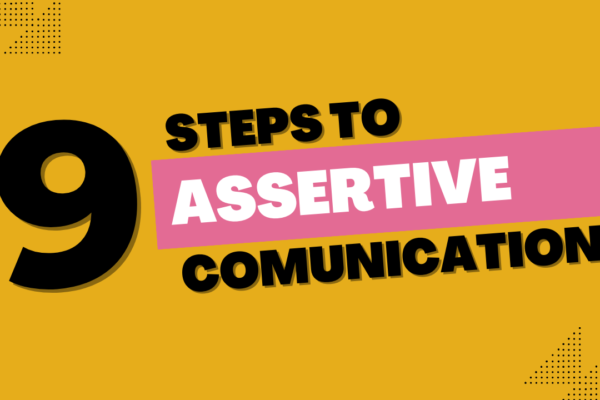Table of Contents
When it comes to boundary setting, learning when to say yes, when to say no, and how to do so skillfully, is the name of the game.
In this post, I will be discussing skills for boundary setting and maintaining healthy boundaries, while preserving the integrity of your relationships.
At the time that I am posting this, it is the week before Thanksgiving, and what better time to talk about boundary setting than the holiday season.
While many of us are looking forward to the festivities, there are often apprehensions that come with family gatherings, as boundary violations and heightened expectations can become unwelcome, but often common, guests in the holiday season.
Becoming skillful in boundary setting is a lifelong pursuit, but the better you become at establishing healthy boundaries in the early formation of relationships, the lower the propensity will be for triggers to manifest in your environment.
Now, that being said, while re-establishing boundaries with long-term friends or family is much more painstaking, it is often the place that we need to start, given the relationships we are closest to are usually the ones we have the most complaints about.
Boundary setting can come easier for some than others. For example, I have always struggled with the word “no.” Yes, I am a “yes man”, (I love that movie). This is likely because I gain satisfaction in serving others and feeling useful; this is probably also why I was a waiter for eleven years through college. I feel energized when I am providing a useful service to others, and I feel pride in it. Even when I was sleep deprived.
My temperament plays a large factor in how I communicate my boundaries to others, and so does yours. Now, while being of service is an admirable value, actions of service and saying “yes” all the time do not always position us to be the most productive, even though our actions may come from generous motivations and genuine intentions.
They say hindsight is 20/20, because when we look into our past decisions, we can see all of the moving pieces and can make informed decisions in retrospect. But the reality is that we live and make decisions in real-time, without knowing all the facts and often have to make an educated guess at what seems to be the most appropriate response to our circumstance. If I had a redo of my college years, I would likely have spread myself less thin, and focused more on the quality of my time and ventures, rather than quantity, in terms of how I invested it. I would like to think since becoming a therapist over a decade ago, that I have become better at this; the truth being, we never quit master this skill, but we get better at adapting our rules around boundary setting to fit the context of our situations.
Burnout is a real issue, regardless of what roles you are currently playing in your life. It is not always clear where our needs end, and serving the needs of others begin, or vice a versa. You see, I had spread myself so thin in college, that I was almost always in a state of burnout, often going 72 hours without any restful sleep between my graveyard job as a waiter, college classes, my internships and volunteering at my church; all noble pursuits, but the intensity at which I was engaging in each, was not always necessary. I could have throttled my investment of time in each domain with more intention, in order to be more present and practice greater self-care along the way. Burnout always comes with risk. Risk of giving up on our goals, risk of damaging relationships because of lowered distress tolerance, and inhibited decision making. I made my own share of poor decisions, and suffered loss and damaged relationships, because I was not taking good care of myself; I was not practicing good boundaries as often as I could have. I have learned to live with more intention, and to prioritize my time and commitments that best serve my core values, especially my values around family and my identity as a father and husband, and as a result, I am even more effective in how I show up and serve in the home and with clients as a therapist.
Trouble saying no can lead to:
- People taking advantage you.
- Feeling unappreciated, stressed and fatigued from doing too much or compromising your values to “make it fit”.
- Becoming Reactionary: Origins are often rooted in childhood, usually stemming from reactionary parents/caregivers, and can lead to fear of saying no or in expressing feelings and opinions in adulthood.
- Fear behind setting healthy boundaries: That it will cost you valued relationships (fear of rejection)
- Reluctance to set boundaries, which creates problems in all areas of life
Boundary setting is:
- Preparing to deal with resistance and sometimes loss of relationships
- A learning process to set and maintain healthy boundaries and is a gradual process.
- Understanding you can learn to say no lovingly and unapologetically.
When looking to improve your skills for boundary setting, there are #10 guidelines I recommend you consider (from my own experience), which are as follows:
1. Know your thresholds: In order establish boundaries, it is crucial to have a firm idea on where your physical, emotional, mental, spiritual boundaries begin and end. You need to know where your level of tolerance is, and what makes you feel unsafe or burnt out. This way you can better communicate what your limits are to others before you reach your tipping point.
2. Be mindful of your feelings: Studies have isolated two prime emotions as red flags for boundary violations: discontent and anger/resentfulness. When alerted to these feelings, it is ideal to stop and explore their origins. If you notice you are feeling either of these, consider what you have committed to, and if it is reasonable or rational to maintain that level of commitment or role in the relationship (set parameters on your commitments so that you can make room for new ones later).
3. Be direct: Being forthright is not always necessary, but is often the best course of action when your audience, or receiving end, has a different temperament or communication style. In order to establish or clarify your boundaries, you may have to be very specific in your definitions. For example, if a request from another party seems unrealistic in context, you may need to make efforts to negotiate the terms that meet your mutual needs, rather than make efforts to dodge the conversation with vague excuses, because you feel uncomfortable; problem solving role disagreements head-on mitigates the most fallout with boundary issues.
4. Reassure yourself: When confronting boundary violations, we are often met with uncomfortable feelings of fear, guilt, and doubt. These feelings are often more prominent when we feel there is more at risk, such as damaging rapport with someone that is of particular importance to us. It becomes easy to rationalize our tolerating uncomfortable situations or relationship dynamics, because we take on the assumption that we can tolerate or sacrifice more than what we can sustain or what is reasonable in reality, which usually ends up with the relationship terminating anyway, and not usually on good terms, because we reach a breaking point. Boundaries serve as a means to protect us from burnout and compromising our values, which in turn allows us to be our best selves and show up for others in to our best capacities. Setting and maintaining boundaries takes more work on the front end, but we reap everlasting benefits in the long-run; boundaries do require ongoing efforts to maintain, adjust or correct, as circumstances change, but all things worth having in life require effort. And, if we are being honest, the effort we put into sustaining healthy boundaries is far less than the emotional fallout we suffer from not working on them in the first place.
5. Evaluate: Take stock in your thoughts and feelings and give them the respect they are due. If you find that your boundaries are slipping, then examine what has changed in your circumstance, and if that change was due to the external environment, from a direct other, or from your own actions, intentional or unintentional. Once you have identified the contributing factor to the boundary change, then apply your problem solving skills to identify your tangible options; I say tangible because there will be the urge to focus on things that are outside of your control or things that happened in the past; I need you to stay present minded. The resolve may involve a singular clear call to action, such as terminating a commitment, while others may be more convoluted, such as confronting someone you care about, in order to correct a boundary violation or misinterpretation.
6. Read the room: We all possess many different roles at any given point in our lives. Learning to manage role transitions is an important life skill, because change is an ever constant element in our lives. Change is not bad in and of itself, it is actually a crucial part of being happy. Change helps us maintain perspective, appreciate the fragile nature of our existence, makes dreaming and goal planning possible, and fuels creativity and inspiration. The happiest people are the ones who learn to adapt to change effectively. Managing role strain is crucial in boundary setting: All of us hold more than one role at any given time, and sometimes these roles can compete for more attention than we have time, energy or resources to accommodate. If you are feeling depressed, tired, fatigued or frustrated, it is sometimes an indicator that you’re headed toward burnout, because you cannot prioritize competing roles. Consider if your roles have defined boundaries, and if you feel you are committed to more than what you can reasonably attend to, or deliver on, and then consider what you can give up, re-prioritize or delegate to relieve the stress. -In light of your new role, what steps could you take to build a healthier quality of life, and what would be the ideal lifestyle given your new role(s)?
-What kind of social support can you leverage to help you adapt to this new role, and what kind of actions can you take to solicit more support?
-What is the nature of your thoughts around the role transition? If they are limiting or depressed thoughts, what primary concerns do they speak to? If they are unhelpful, how might you reframe your thoughts toward a healthier perspective?
-What are the actions you can implement immediately to better acclimate to the new role or change that has occurred?
7. Self-Compassion: Self-care might seem like a basic premise at first glance, but it is more than managing the obvious, seemingly routine tasks of our day, like making the bed, taking a shower, or eating. Self-care encompasses the things in our routine that require intention, and help us feel balanced and at our best. For example, if you used to make it a staple in your routine to work out 3x/week, but since having a child, or taking on a new job, you have cut down or stopped working out entirely, than your self-care is off kilter. Now, life is full of change and it is perfectly normal to let some things go to accommodate new change while we acclimate, but we can always circle back and experiment with methods to attend to our values. It may not look the same as before, but we can scratch the same itch, and often times, we are happier with the newfound routine.
8. Soliciting support: If you find yourself struggling to find ways to set healthy and meaningful boundaries on your own, get someone in your corner, a good sounding board to help you think it through. This could be a therapist, a life coach, a sponsor, a spiritual advisor, a best friend, a gym buddy or trainer, or a role model/podcaster (my personal favorite).
9. Use assertive communication: Setting healthy boundaries requires that we are able to both visualize what they look like in real time in their real life application, and also communicate them in a clear and concise fashion to others, while communicating and demanding mutual respect. Learning the different types of communication is a discussion for another day (learn more in this previous post on the subject).
10. Operationalizing your boundaries. Like any goal we postulate, and then conceptualize, we must find ways to implement them, or operationalize them, into our daily lives in an incremental fashion. The best place to start experimenting is in your comfort zone, with people and circumstances in which you feel safe and confident to do so.
In conclusion, I applaud you for taking the time to learn about boundaries and why living with intention in this area of your life is so important for you quality of life. Boundary setting is a very large topic of discussion with many facets that we could deep dive into, and will in future discussions.
It has been a pleasure serving you.
RECAP:
1. Know your thresholds:
2. Be mindful of your feelings:
3. Be direct:
4. Reassure yourself:
5. Evaluate:
6. Read the room:
7. Practice Self-Compassion:
8. Solicit support:
9. Use assertive communication:
10. Operationalizing your boundaries:
UP NEXT: How To Improve Your Support System
Recommended Reading
Heads up: This article/page does contain affiliate links to products sold on Amazon, which I recommend in the context of this discussion, because they have proved to be helpful to me and/or my clients. As an Amazon Associate I earn from qualifying purchases by way of commission at no additional cost to you.

ASK: If you have a question you’d like me to answer here on the blog (even if you think it’s a silly one!), please use the form on the CONTACT ME page, or the comment section below. I would be happy to take a poke at it and provide a long form answer when appropriate.
SHARE: Also, be sure to share it with a friend, as there is still a lot of work to be done in raising mental health awareness.
SUBSCRIBE to get your FREE MOOD TRACKING TOOL and quick Mental Health Hacks in addition to this newsletter. Sign-up with the form below.
NEED CRISIS HELP? If you need immediate crisis help with your depression, you can call the National Suicide Prevention Lifeline at 1-800-273-8255 or text “START” to 741-741
OUTSIDE THE UNITED STATES: See International Suicide Hotlines
WHERE TO FIND MENTAL HEALTH HELP:
-NAMI Referral Helpline: 1-800-950-6264
-California’s Statewide Mental Health Helpline: 1-855-845-7415
admin
Latest posts by admin (see all)
- ADHD Tips for Therapists | with Dr. Jennifer Dall - May 28, 2025
- Why Therapy Fails Men (And How to Fix It) – Insights with Marc Azoulay - May 11, 2025
- The 4 Relationship Attachment Styles: What Every Therapist Needs to Know - April 26, 2025





